The Phonecian Gold Jewelry from Kition, Cyprus
By Pavlos Flourentzos & Maria Luisa Vitobello
Abstract:
In 1998 a built tomb was excavated at the southern outskirts of Larnaka Town in the direction of the airport. The tomb was numbered MLA 1742 and included a unique collection of jewelry that likely adorned the deceased. Their assemblage totaled twenty-three pieces from various jewelry typologies, manufactured in gold and ornate with semi-precious stones. The tomb shows several ritual similarities with the famous Royal Tombs of Salamis. It can be suggested that here was buried a member of the Kition Phoenicians upper classes, possibly even a member of the royal family of this city. The tomb is dated around the end of the 8th century B.C. when Cyprus was under a strong oriental influence due in all probability to the presence of Phoenician settlers in Kition. Various goldsmithing techniques, such as granulation, cloisonné etc., were applied for production. Some of the jewelry typologies are quite rare or even unique. The rings and swivel rings found in the tomb show a strong Egyptian influence revealed in decorative representation of various Egyptian deities and other Egyptian motifs.
The variety of jewelry and their well-known find spot will provide scientists the opportunity to study the hoard and gather more precise data that will facilitate the investigation of similar artifacts in the future. A pilot study, reported under authors Dr. Maria Filomena Guerra and Prof. Thilo Rehren within the AUTHENTICO research project activities, was carried out on the artifacts; in the study, the high carat of the gold alloys used in fabrication of the jewelry was confirmed by XRF characterization; the pilot study was carried out to help future attribution of certain historical period production, to authenticate by separating genuine objects from modern copies or extensively restoring items and developing anti-fraud measures.
Keywords: cloisonné, Cyprus, fibula, granulation, jewelry, Phoenicia.
Introduction
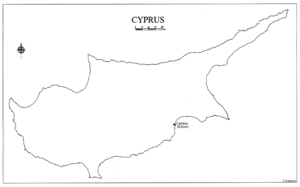
Kition was one of the most important kingdoms of Cyprus, lying in the south-eastern part of the island (see map on right) and hosting one of the most significant hoards of Cyprus in Antiquity. The ancient town has a Mycenaean prehistory; however, it also flourished since the 9th century B.C., when an important tribe of traders and seafarers came to colonize the area. Those seafarers were of course Phoenicians, originally from the famous city of Tyre in the Levant.
Since the Ancient and Classical periods (8th to 5th cent. B.C.), a Phoenician dynasty was ruling Kition. In 1998, an isolated built tomb – as it was not part of a wider necropolis – of monumental architecture was excavated in the south-western outskirts of modern Larnaca. The tomb had a chamber and a dromos where sacrifices of horses were exposed, with bronze components from the horses’ harnesses. Inside the tomb, due to a great amount of water flowing in throughout the centuries, completely deteriorated bones were found.
Apart from the jewelry that is presented below, also various vessels imported from Phoenicia were found. Worthy of note is an amphora showing a unique decoration, which was closed with a lid. The jewellery consists of various typologies of pendants and beads (part of a necklace or necklaces), earrings, bracelets, rings and a unique gold fibula.
An additional outstanding bead (MLA 1742/29) is executed in a stone – probably marble – a bull´s protome delicately carved to enhance the eyes, nose, ears: the forehead is decorated with the Astarte sun disc, represented by carved dots. The bezel which surrounds the bead is obtained from gold sheet; two decorative rows of round wire and a central row of braided wire are positioned and fused along the lower side of the bezel, encircling the seal; both bead and bezel are pierced through in the top part to allow threading, while the two opposed holes are bordered by two round loops. The height of the pendant allows for an engraved back side seal representing a goddess with uplifted arms.
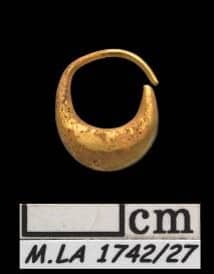
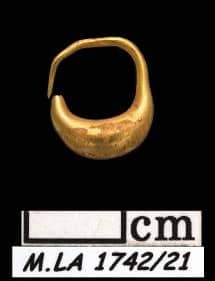
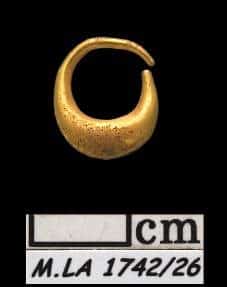
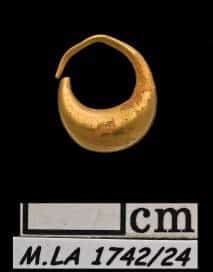
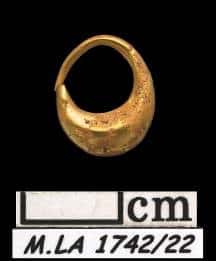
Five earrings were found: all of the boat or leech shape typology, forged from a single piece of solid cast gold, hammered and shaped as a crescent. One end of the crescent extends to form the hanging hoop from which the hook is tapered, smoothed out into a fine needle for insertion into the ear.
Rings
Three rings of solid gold were revealed from the tomb. The first one (MLA 1742/1) is a gold ring with an ivory intaglio bezel. The hoop and the bezel were worked separately; the ring is made of a single piece of solid gold, cast in a mold, while the hoop’s surface is roughly finished by burnishing. The upper side of the hoop has an elliptical bezel, bearing a separate seal device. The sphragistic device, broken into three pieces, is engraved representing an ibis standing on its side while the background is filled with crossed lines representing bamboo or papyrus.
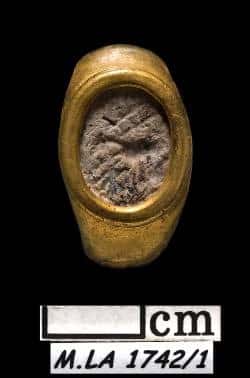
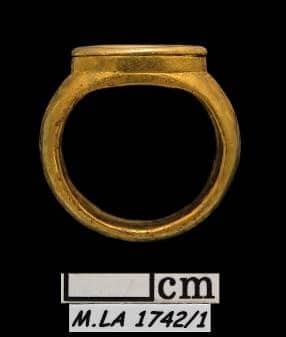
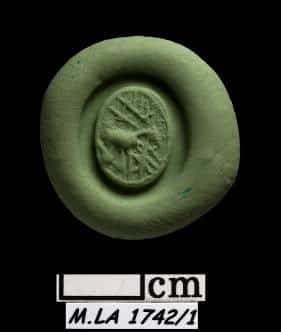
The second one (MLA 1742/2) is a gold ring with an indigo (sodalite) intaglio gem. The artifact has an identical structure and manufacturing techniques as the previous ring, having also an elliptical bezel with a removable seal device. The sphragistic device is engraved and depicts the Egyptian goddess of life Maat with a feather. The goddess Maat was the personification of the basic laws of all existence; she embodied the concepts of law, truth and world order. In Egyptian tradition, judges were regarded as priests of Maat.
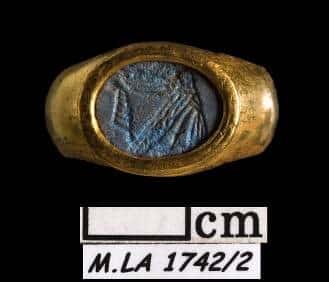
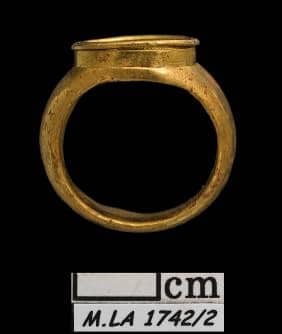
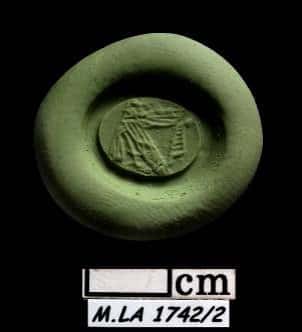
The third one (MLA 1742/3) is also a gold ring with faience intaglio. The manufacturing techniques are similar to those already mentioned above; the seal however is not removable, possibly to withstand daily use. Another interesting feature of this ring is that the intaglio, broken and partly worn, possibly depicts an ibis and a feather.
Bracelets
The tomb also yielded two unique bracelets. The first one (MLA 1742/18) consists of two parts: a ribbon bracelet and a circular box setting, holding a discoid cabochon agate, having at the center an eye, reminiscent of (sic) the eye of Horus, in ancient tradition an apotropaic significance. The stone is set into a box setting the sides of which and top-frame are granulated. The strap consists of a ribbon obtained from four parallel double loop-in-loop chains, threaded through by additional loops linking the chains and forming the braided strap up to the desired length. At both ends of the ribbon, the finials have their loops extended by approximately 25mm to provide hinges through which pivots connect the ribbon to the box setting. The box setting is decorated with a row of granules and alternating granulated triangles; a row of granules runs along the full length of the side; a border of round wire encircles the whole side below, with an additional double braided wire above the round wire. A thin top plate is fused to cylinder forming the outer wall of the box; starting from the outer edge, the center frame is decorated with a circle of round wire and a row of granules alternating with granulated triangles pointing inward towards the center of the box. A second row of granules, showing granulated triangles pointing outward from the center and a circlet of round wire delimitate the inner border of the frame. On both sides of the box, diagonally opposed, tiny cylinders obtained from coiled wires, form the hinges through which the pivots are inserted to connect the ribbons’ hinges to the box setting.
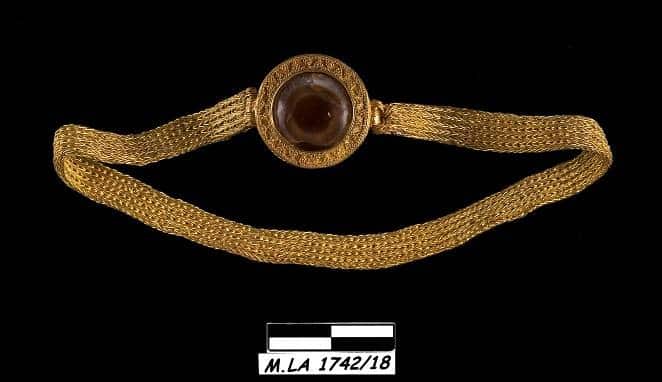
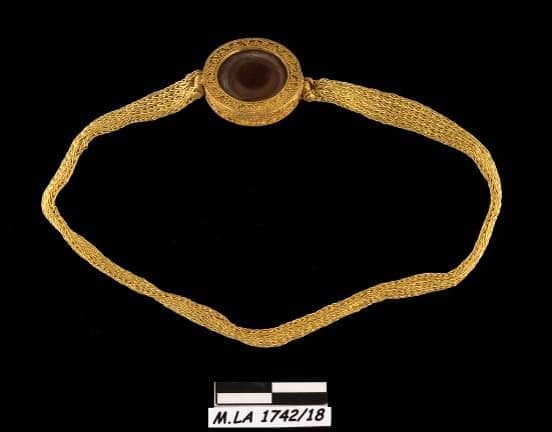
From a technical and an artistic point of view, this bracelet is extremely attractive and rare; if considering the manufacturing techniques, the combination and refinement of the applied competencies and skills of the ancient craftsman that make this artifact more than exceptional worldwide.
The second bracelet (MLA 1742/19) is manufactured with an entirely different technique. It consists of a quadruple loop-in-loop chain, with a wire diameter of 0.4mm. and a chain length of 180 mm. At both ends of the chain, an inner tapering wire pivot is inserted through the scarab’s suspension-hole to allow swiveling; the wire is wound into and around the bracelet’s final loops, coiled fourfold around itself to secure the scarab. The scarab is set inside an elliptical bezel, with its sides at both ends smoothly rounded off, two globules (recalling dung-balls) holding the scarab. The globules are embossed, joined to the bezel by fusing. Both globules show a round hole in the lower part, to allow the connecting tapered wire to pass through. The scarab is carved both on the soft round top and flat on the backside, its surface is decorated with an inscription showing Egyptian hieroglyphics: on its lower part, two goddesses seated side by side and three “beathyls” topped by a cartouche. The cartouche is typically evidence of objects often associated with Pharaoh.
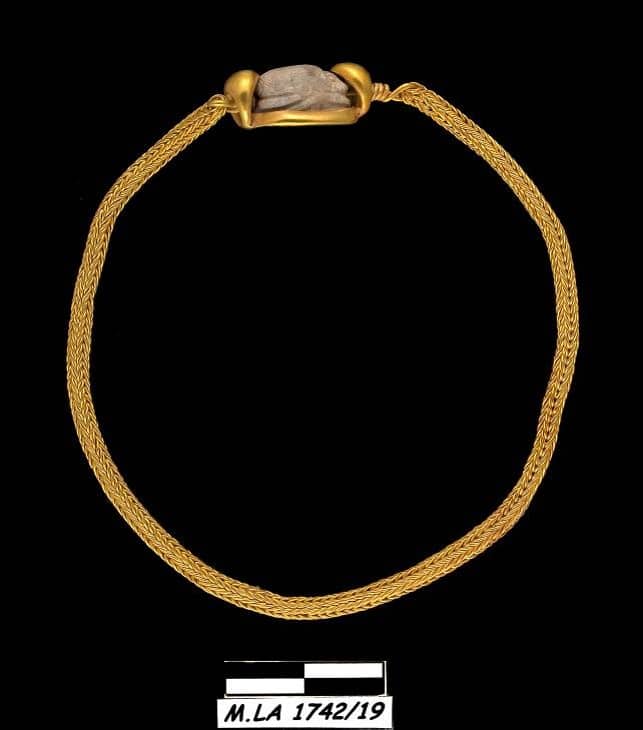
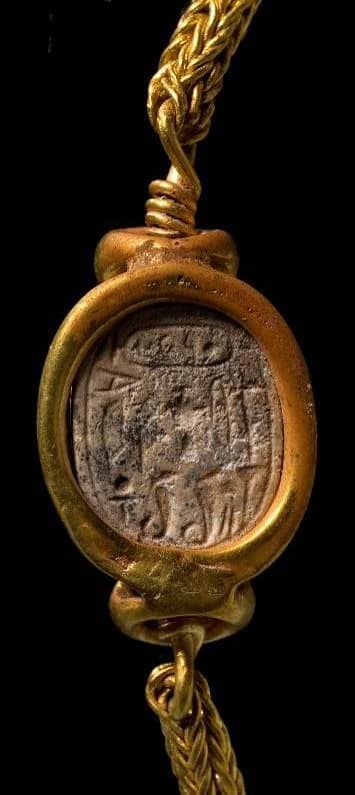
The Necklace
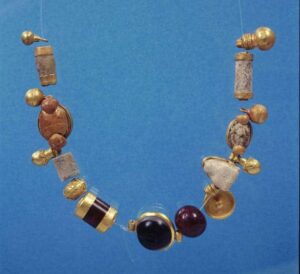
Another important find is an extraordinary necklace consisting of seventeen beads and pendants of various shapes and significance. The gold elements of the necklace are obtained from high-carat natural gold alloy, confirmed by further characterization, (pilot study Guerra and Rehren). One of these is a gold sheet disc (MLA 1742/25) (Fig. 5) made of beaten gold sheet and framed by a round wire edge fused onto it. A large granule is positioned in the center of the disc. Such a disc is a diagnostic symbol of the goddess Astarte, often represented ornated with a crescent, the goddess symbols. Three beads of this necklace (MLA 1742/34, 6, 7) are spherical, made of high-carat gold alloy obtained by joining two hemispheres, each one embossed out of thick plate. The joining of the two halves is clearly outlined by magnification. The upper hemisphere is pierced at the top, where a small round suspension loop is inserted and fused.
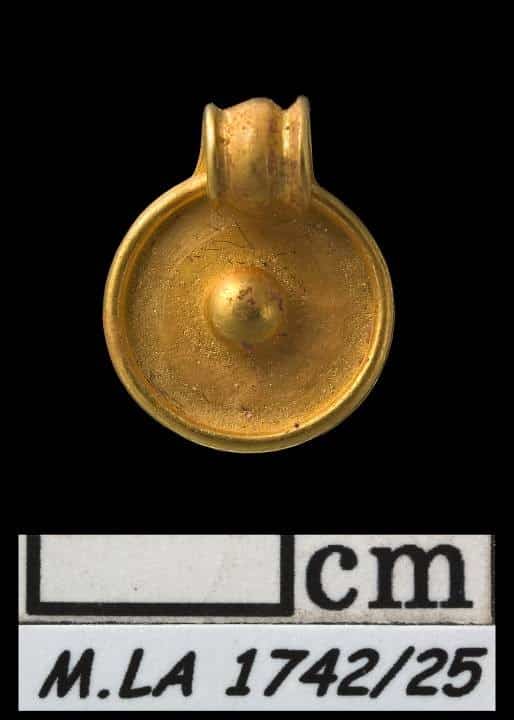
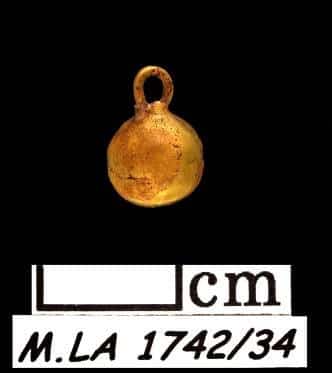
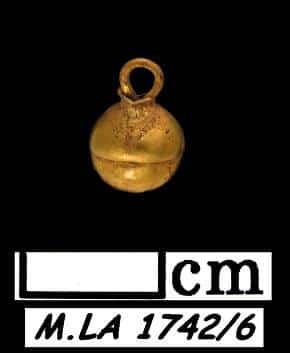
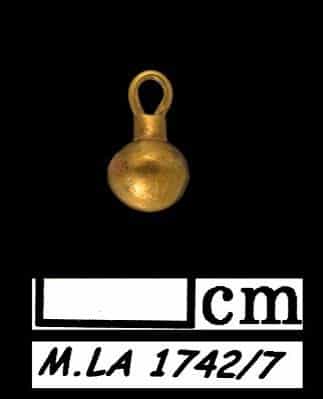
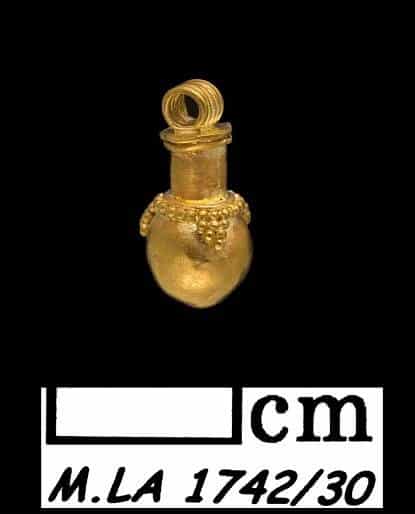
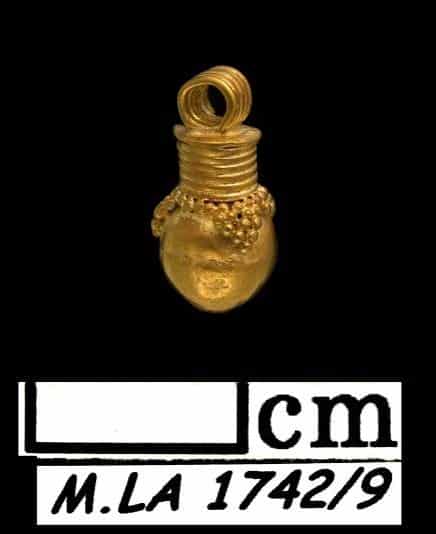
The necklace also consists of four cylindrical beads (MLA 1742/17, 28, 31, and 32). Three beads are made from marble and agate; (numbers 28, 31, 32) pierced longitudinally and fitted at both ends with gold sheet finials. The other one, no. 17, is made from ivory, is plain and does not bear golden sheet finials.
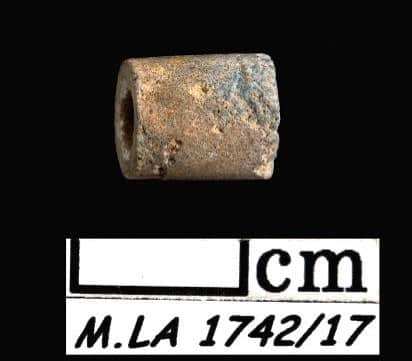
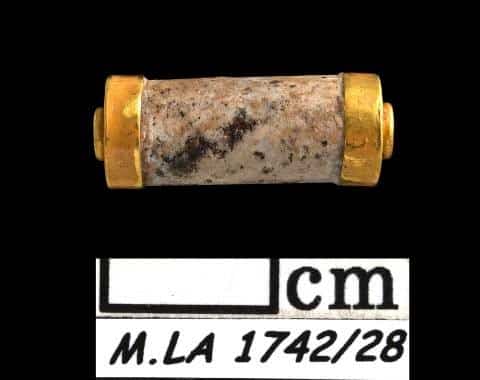
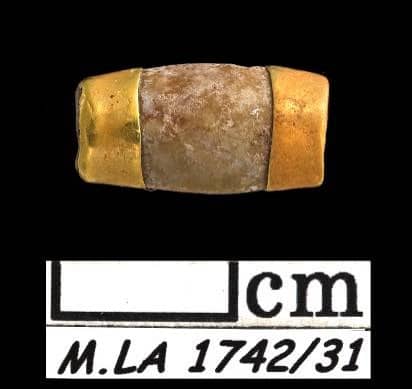
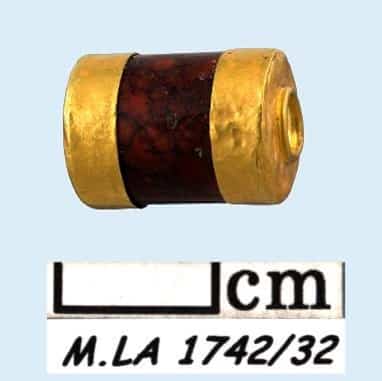
Another element of the necklace is a plain spherical agate pierced through ( MLA 1742/33).
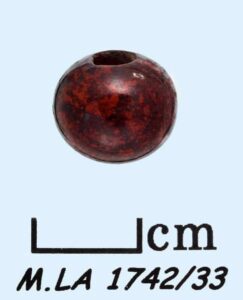
An additional outstanding bead (MLA 1742/29) is executed in a stone – probably marble – a bull´s protome delicately carved to enhance the eyes, nose, ears: the forehead is decorated with the Astarte sun disc, represented by carved dots. The bezel which surrounds the bead is obtained from gold sheet; two decorative rows of round wire and a central row of braided wire are positioned and fused along the lower side of the bezel, encircling the seal; both bead and bezel are pierced through in the top part to allow threading, while the two opposed holes are bordered by two round loops. The height of the pendant allows for an engraved back side seal representing a goddess with uplifted arms.
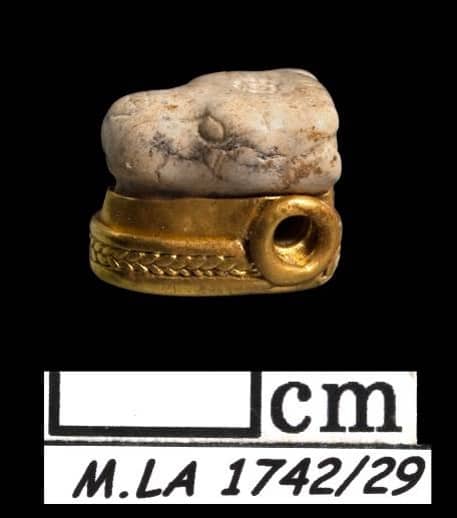
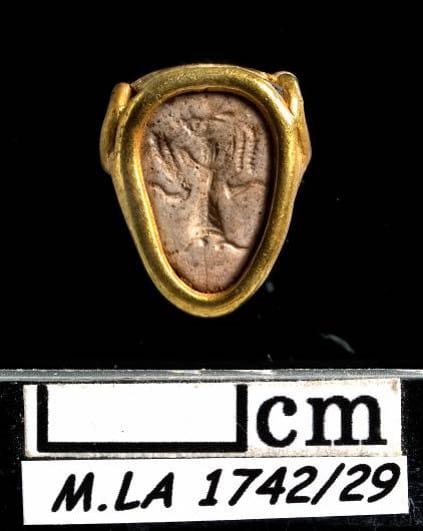
Further elements of necklace are two scarabs (MLA 1742/4, 5). No. 4 consists of an engraved faience scarab, pierced longitudinally for suspension. On each side of the opening, two globules (dung-balls), obtained by embossing thin gold plate, are fused to the bezel, holding the jewel. The high bezel is made of gold sheet; the scarab’s backside seal is engraved, showing centered on the surface an alabaster bottle, flanked by two “C” shaped ornaments and on the outer edge, on both sides, two ankhs symbols are engraved.
Another scarab (no. 5) is quite unique in its conception; it is composed of two superimposed elements: a scarab, obtained from embossed gold sheet, with delicate features reproducing the animal’s details, is positioned over a back seal stone in turn set into a golden bezel. The entire upper gold surface of the embossed scarab has a patina the origin of which needs further investigation. The back side seal, positioned under the golden carapace, is also carved, showing probably a hieroglyphic symbol flanked by two feathers.
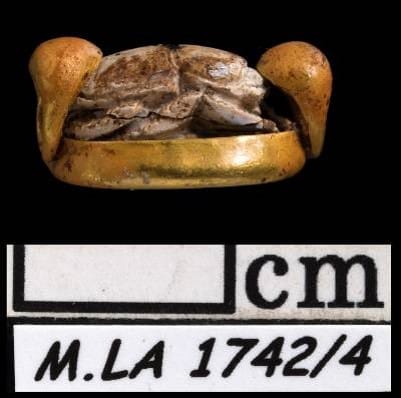
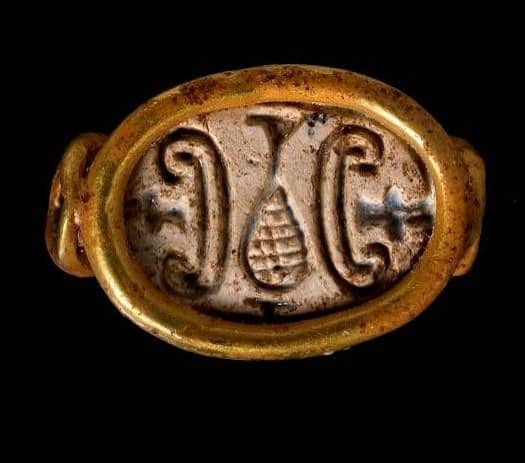
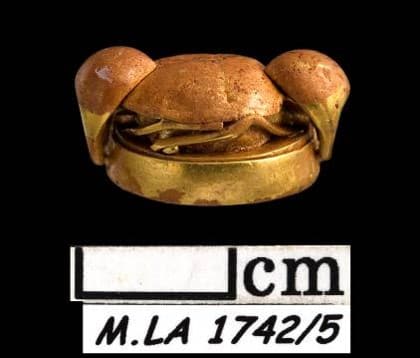
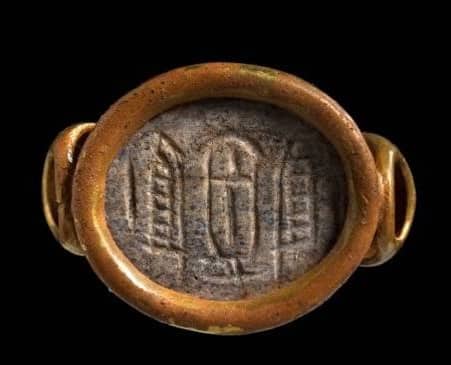
Finally, the necklace has two further golden beads. The first (MLA 1742/16) is made of gold alloy, possibly representing a vase; the body is topped by a cylindrical neck, its upper part decorated with one loop of round wire, one loop of braid wire (two twisted wires facing opposite direction) and loop of round wire; the wires are fused onto the neck surface.
The second bead (MLA 1742/8) has a lentoid shape, is obtained from two hemispheres of embossed gold sheet; the bead is open on both sides to allow threading; both sides of the opening are bordered by rows of granules: Along the circumference, two rows of granules define each hemisphere; along each row, six granulated triangles, alternating with six granulated lozenges, decorate both the upper and the lower hemisphere of the bead.
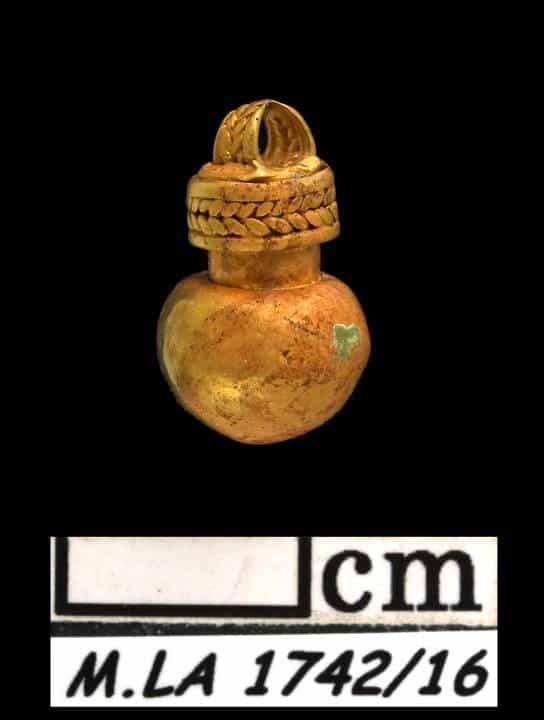
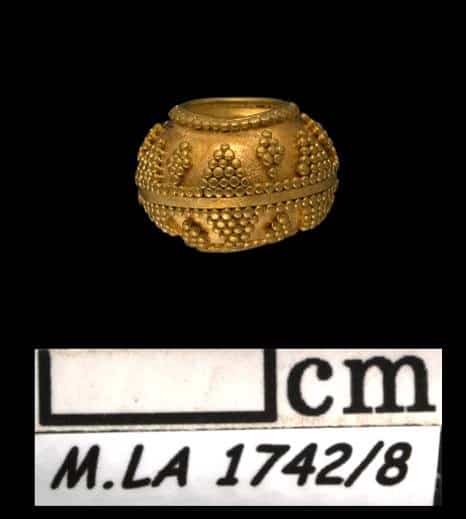
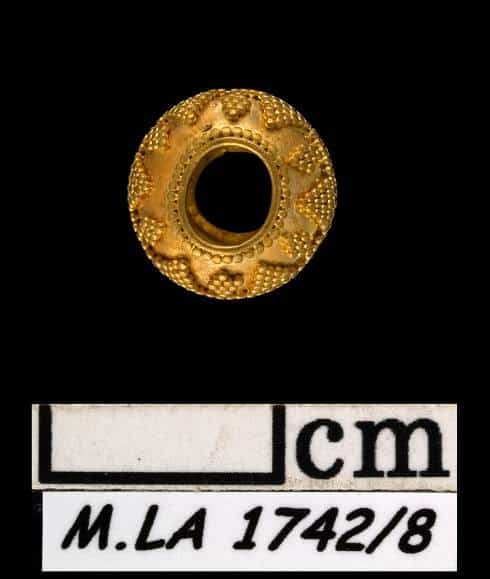
The Fibula
The gold fibula (MLA 1742/20) (Fig. 6) is obtained from a single gold rod, skilfully forged to the desired triangular shape, which recalls an inverted bow: The bow is pinched at the top into a loop from which both sides extend and are elegantly shaped into inverted curves; on one side, the body flows into the coiled spring, and then tapers into the needle; on the other side, the body is forged shaped into the foot and catch plate: This typology of fibula is defined as an inverted bow-shaped fibula . As decorative elements, three cloisonné rosettes are positioned on the top and on both sides of the fibula; it is worth mentioning the Egyptian influence of these particular elements: similar rosettes decorate the head-dress of an Egyptian lady, court of Tuthmosis III, 18th Dynasty, 1450 B.C., Thebes.
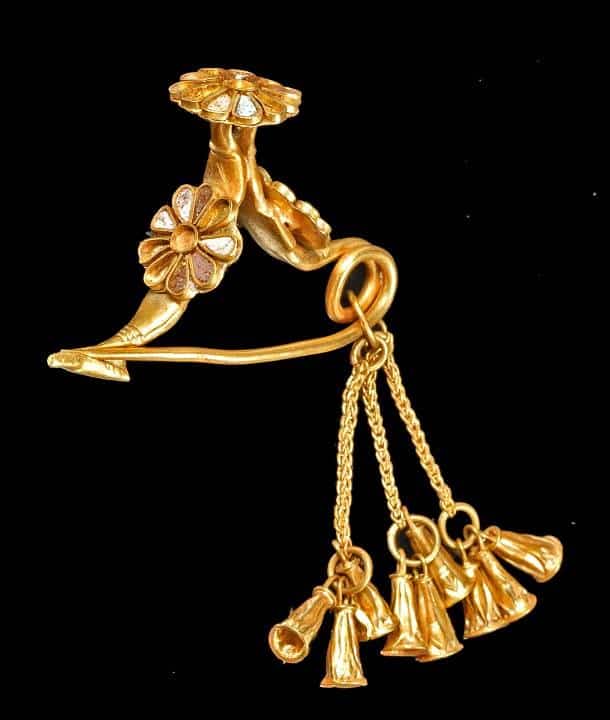
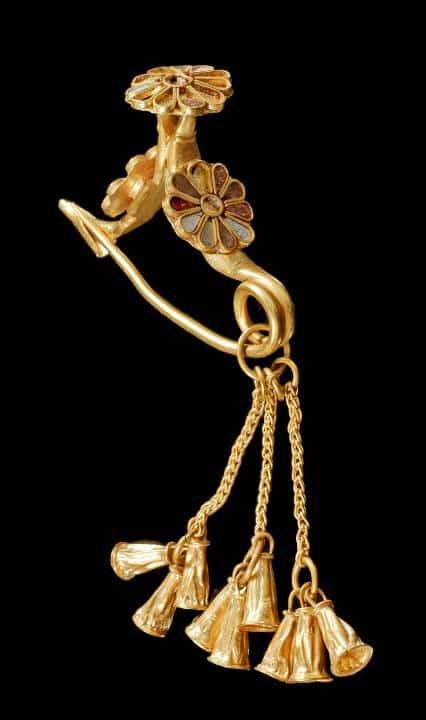

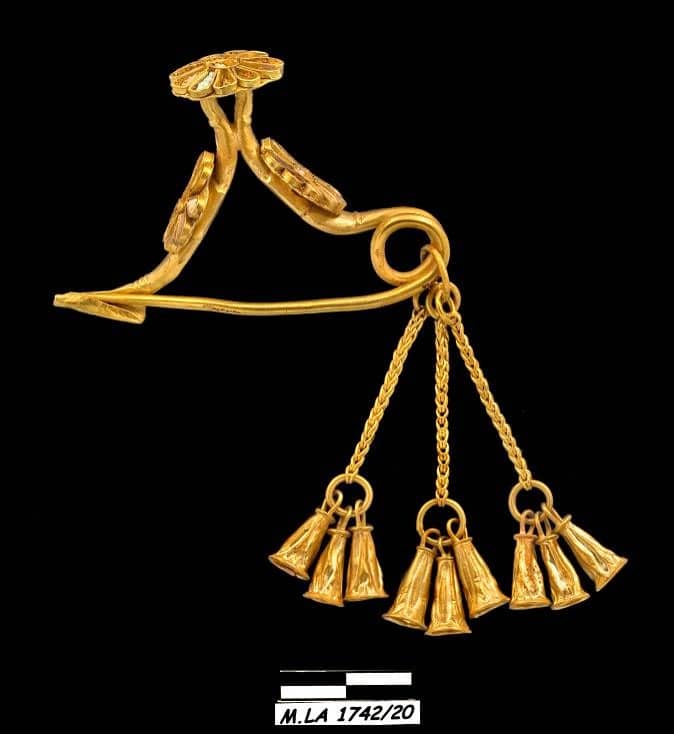
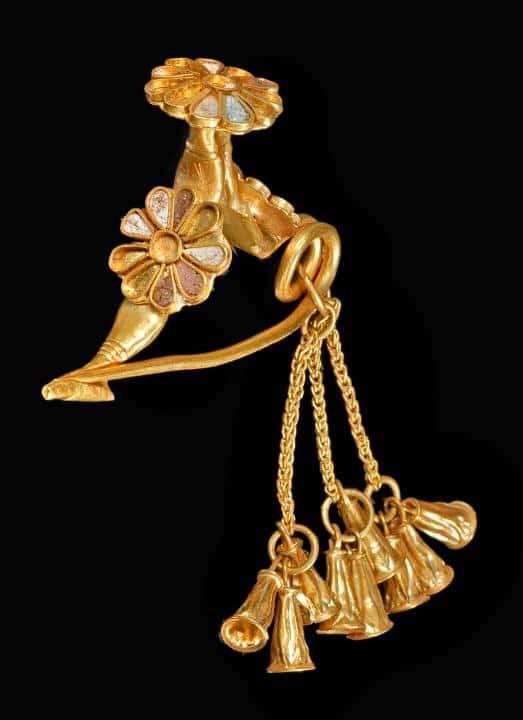
The top rosette is eleven-petaled, the right rosette (facing the coil) is ten-petaled, while the left rosette (facing the catch-plate) is nine-petaled. Each rosette is obtained from gold sheet, strips of which form the cloisons. The cloisons outline the petals which are filled with polychrome enamels of various colors. Additional decorative elements of the artifact are double loop in loop chains linked to the coiled spring: from each chain, connected by means of suspension rings, three delicately chiseled bells, recalling stylized lotus buds, are hanging. A further extraordinary feature of this fibula is an alef (a Phoenician letter) engraved on the front side, above the rosette, probably representing the owner´s name initial letter. During the Late Cypro-Geometric and Early Cypro-Archaic period (circa 850-700 B.C.) this typology of fibulae were mostly made of bronze; the shape is typically and diagnostically Cypriot, often found in tombs of the above mentioned period all over the island. Very rarely, this kind of fibula is made of silver: the fibula from the Kition-Larnaca built tomb no. 1, is a golden work of art of exceptional importance for Cypriot and world heritage.
The Fibula: Historical and Artistic Context
Preliminary to a final publication which will reconstruct the excavation’s context and methodology, some introductory content is provided in this paper aiming at framing the artifact within its historical and archaeological context.
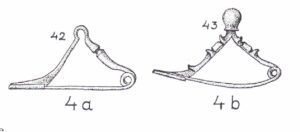
The fibula’s main body, of irregular triangular shape, can easily be referred to Type 4b (Fig. a)of the Cypriot fibulae according to the criteria already presented by the Swedish Cyprus Expedition and further confirmed by the typological analysis (Stronach, 1959): this is an original Cypriot typology.
The chronological horizon appears to be clearly established at the VIII-VII century B.C. (Cypro-Geometric period) tending to a lower dating of such chronology. This typology is common in the Syro-Palestinian area, in the Anatolian and Aegean environments, especially Rhodos and Aegina.
Characteristic features of the Kition fibula are the addition of three chains and lotus bud pendants and above all, the exceptional enrichment of three cloisonné rosettes to the main body, enhanced by polychrome enamel cloisons, respectively placed two at the center of each of the fibula’s arms and one to top the fibula’s apex.
With their curved shape both fibula’s arms appear to recall the Egyptian solar boat: this appears evident in the bows’ shape, which meet towards the apex with an elegant decorative effect, while the two rosettes, topping both arms, are placed in the area where usually the cabin is located.
Such tendency to use Egyptian or Egyptianizing elements or symbolism in such an eclectic and audacious way, is a typical and founding aspect of the Phoenician art, of which the Kition fibula is certainly one of the most original and uncommon examples. (Ciafaloni, 1995). Not only in jewelry, but also in glyptic arts (i.e. on a chalcedony scarab at the Louvre Museum) and in ivories (Herrmann), the solar boat symbolism is widely asserted, represented in numerous and ingenious variations with respect to the classical Egyptian interpretation.
Phoenician sumptuous objects had a widespread diffusion with all the Mediterranean élites, in this particular instance in its oriental area, in the chronological span already identified, and in particular in Cyprus, as shown in the so-called Cypro-Phoenician bowls (Markoe, 1984) which constitute the most evident manifestation of such an eclectic trend.
Within the Levant and Cypriot environment, the Phoenician craft is permeated with Mesopotamic and Near-Eastern influxes; in fact it can be probably stated that it shares an ample aesthetic and technical Koiné only partially known.
Notwithstanding, the extraordinary recent discovery of the Nimrud Queens Tombs (Damerji, 1999) has added an impressive quantity of artifacts to the meager dossier related to Mesopotamic jewellery from the I millennium B.C.
As an example, cloisonné and champlevé techniques are widely witnessed by the application of enamels and semi-precious stones in-lays on sumptuous bracelets. (Ibidem, Abb.27-30) till now known only from relief reproductions of the neo-Assyrian palaces.
It then appears that not only Egypt should be taken into consideration as a source of the decorative technique applied on the rosettes, even if, since the New Kingdom period, there are undoubtedly copious testimonials of floral elements characterized by these techniques (see the head-dress of a Tutmosi’s III wife from Thebes now at the Metropolitan Museum) as well as in Mycenean setting (ANAM, 1988).
To conclude, it could be stated that in the Kition fibula, the corpus of Egyptianizing in general elements recalling the religious world, steers towards an eschatological and symbolic interpretation of the artifact, possibly destined, since its creation, to a real use in everyday life, to be worn by a prince or a member of the Kition aristocracy, as well as for funerary use.
Furthermore, the rosette motive in the Mesopotamic area appears linked to the major oriental female goddess Ishtar/Astarte, i.e. in neo-Assyrian setting, chronologically parallel (VIII century B.C.) to the Kition fibula: cloisonné rosettes appear on a bracelet from the already mentioned Nimrud Queens Tombs (Damerji, cit, Abb. 30) where the same goddess is represented in the bracelet center-plate. Taking into account the already identified eclectic and syncretic orientation of the Phoenician culture, it is possible to assume that both sources, the Egyptian and Mesopotamic, efficiently merge into a certainly unique artifact.
Acknowledgments
With thanks to Prof. Davide Ciafaloni, Università di Milano Bicocca, Italy, for his collaboration and contribution concerning the Kition fibula humanistic aspects of the research.
Sources
- Ciafaloni, D., 1995, Iconographie et Iconologie, in V. Krings ed., La civilisation phénicienne et punique. Manuel de recherche, pp.535-49. Leiden
- Culican, W., 1966. The First Merchant Venturers, the ancient Levant in History and Commerce. London.
- Damerji, M.S.B., 1999. Graeber Assyrisher Koeniginnen aaus Nimrud, Mainz
- Geling, U., Viemer, H.-G., 1990. Die Phoenizier in Zeitler Homer. Mainz.
- Gjerstad, E., 1948, Swedish Cyprus Expedition, Vol. IV, part II, Arts & Crafts. Bronze, Page 145, Figure 26, Bronze, 4a and 4b. Stockholm
- Hadjisavvas, S., 1999. Chronique de fouilles et decouvertes archeologique á Chypre. In BCH (123).
- Herrmann, G., Ivories from Nimrud IV,2. from Room SW37 Fort Shalmeneser Ivories, nn. 989-994, Pls. 2255-57
- Heiniger, E.A. and J., 1974. The Great Book of Jewels. Lausanne.
- Karageorghis, V., 1976. Kition. Thames and Hudson, London.
- Markoe, G., 1984. Phoenician Bronze and Silver Bowls from Cyprus and the Mediterranean, Los Angeles
- Moscati, S., 1998. The Phoenicians. Milan.
- National Archaeological Museum, 1988, The Mycenean World. Five Centuries of Early Greek Culture 1600-1100BC. Athens
- Pierides, A., 1972. Jewellery in the Cyprus Museum. Nicosia
- Stronach, D., 1959. The Development of the Fibula in the Near East, Iraq, 21, , pp.180-206. London